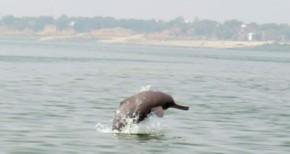
Gangetic Dolphins Threatened by Multi-Class Chemicals: Study
The majestic Gangetic dolphins, an iconic species in the Indian subcontinent, are facing a new threat to their survival. A recent study published in the journal Heliyon has revealed that these gentle creatures are exposed to health risks due to the presence of multi-class endocrine-disrupting chemicals (EDCs) in their diet. The study, which investigated the dietary exposure risks of 39 multi-class EDCs to mammals, has raised concerns about the impact of these chemicals on the Gangetic dolphin population.
According to the study, elevated bioaccumulation of EDCs was observed across prey fish species of Gangetic dolphins, indicating a significant exposure risk to these mammals. EDCs are a class of chemicals that can mimic or interfere with the body’s hormones, leading to a range of adverse effects on the environment and human health. The presence of these chemicals in the diet of Gangetic dolphins can have severe consequences for their health and well-being.
The study, which analyzed the presence of EDCs in prey fish species, found that several pesticides, including DDT and Lindane (γ-HCH), were detected in the samples. These pesticides, which were banned or restricted in many countries due to their harmful effects on the environment and human health, are still being used in India, highlighting the need for stricter regulations and enforcement.
The findings of the study are alarming, as they suggest that the Gangetic dolphins are not only exposed to EDCs through their diet but also have elevated levels of these chemicals in their bodies. This bioaccumulation of EDCs can lead to a range of adverse effects, including reproductive and developmental problems, immune system dysfunction, and even cancer.
The Gangetic dolphin, also known as the Ganges River dolphin (Platanista gangeticus), is a vulnerable species that is found in the Ganges-Brahmaputra river system in India and Bangladesh. The species is facing numerous threats, including habitat destruction, entanglement in fishing nets, and pollution. The presence of EDCs in their diet is a new and emerging threat that needs to be addressed urgently.
The study highlights the need for urgent action to reduce the use of EDCs in the region and to monitor the levels of these chemicals in the environment. The Indian government and other stakeholders need to take immediate steps to phase out the use of harmful pesticides and to promote sustainable agriculture practices that minimize the use of chemicals.
The study also emphasizes the importance of monitoring the levels of EDCs in prey fish species and in the bodies of Gangetic dolphins. This will help researchers to better understand the extent of the problem and to develop effective strategies to mitigate its impact.
The findings of the study have significant implications for the conservation of the Gangetic dolphin and the broader ecosystem. The species plays a crucial role in maintaining the balance of the ecosystem, and any decline in their population can have cascading effects on the environment.
In conclusion, the study highlights the urgent need for action to protect the Gangetic dolphins and the environment. The presence of EDCs in their diet is a significant threat to their survival, and immediate steps need to be taken to address this issue. The Indian government, other stakeholders, and the general public need to work together to reduce the use of EDCs, promote sustainable agriculture practices, and protect the Gangetic dolphins and their habitat.






